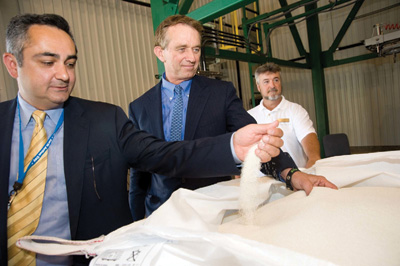
The world is awash with phosphorus, and yet it is also running out of
the precious nutrient. As a key nutrient in the foods we eat, phosphorus eventually makes its
way through us into a waste stream.
The world is awash with phosphorus, and yet it is also running out of the precious nutrient.
As a key nutrient in the foods we eat, phosphorus eventually makes its way through us into a waste stream. As a result, landfills, lakes, streams and oceans are inundated with excess phosphorus from our waste. However, phosphorus mined from phosphate rock, which is used in most commercial fertilizers, is a finite source.
 |
| President and CEO Phillip Abrary and board member Robert Kennedy Jr. look at Crystal Green fertilizer produced at the Chesapeake Bay plant. PHOTOS COURTESY OSTARA |
This presents the challenge of finding a new, sustainable source of phosphorus. Two researchers from the University of British Columbia decided to tackle this problem. Drs. Fred Koch and Don Mavinic developed a safe and efficient method to remove phosphorus from wastewater and licensed the technology to Ostara Nutrient Recovery Technologies in 2005.
RESEARCH CREATED A WIN-WIN SCENARIO WITH NEW PRODUCT
Phosphorus builds up in wastewater treatment plants, and when mixed with other nutrients, such as ammonium, it produces a scale in the facilities called struvite, which clogs pipes much like cholesterol does arteries. Although struvite is high in phosphorus, it is not suitable as a fertilizer source. It also causes operational problems for wastewater treatment plants. Ostara’s technology consists of fluidized bed reactors that take the components of struvite and supportsa chemical reaction that forms crystalline fertilizer prills, sold as Crystal Green®.
 |
|
| Ostara VP Jim Zablocki
|
The technology progressed from the lab to commercial scale with the launch of the first full-scale facility in Edmonton in 2007. Since then, Ostara’s Nutrient Recovery Facilities have been installed in Oregon and Virginia, with a fourth plant opening in Pennsylvania this fall. Pilot programs are currently underway in the U.S., Europe and Asia.
This technology is the first of its kind, harvesting 85 per cent of the phosphorus in a liquid waste stream to make a sustainable slow-release fertilizer that has agronomic uses in the horticultural trade with the absence of metals or pathogens. Crystal Green is also being used for salmon restoration in streams by the Department of Fisheries in British Columbia.
ADDITIONAL UNIVERSITY TESTING CARRIED OUT IN FOUR U.S. SCHOOLS
Recent research in nurseries and greenhouses at Oregon State University (OSU) and the University of Arkansas shows that Crystal Green will last eight to 12 months in soilless media. Field studies conducted at North Carolina State and Virginia Tech show that you can use one-sixth the amount of phosphorus compared to soluble forms and get better results.
Trials preformed at OSU with three different species of plants show that one can use Crystal Green instead of coated forms of phosphorus and get equal results.
In our studies, we’ve found that phosphorus is taken up by the plant more efficiently from Crystal Green than any other form of phosphorus. Additionally, the OSU trials showed that less phosphorus was leached compared to coated products.
 |
|
| The Crystal Green treatment (centre) in University of Oregon fertilizer trials in 2009 conducted by Dr. Jim Owen. |
Water or hydrolysis is the only means of releasing the nutrients. So excessive temperatures will not influence Crystal Green’s release compared to coated CRF products, which is very important for potted crops or hanging baskets. Crystal Green can be incorporated in soilless media and stored with no concerns. The fertilizer also contains 10 per cent magnesium, which results in darker, greener and fuller ornamental crops. The magnesium lasts as long as the phosphorus. If used at low rates Crystal Green’s flat release curve will not cause excessive stretching compared to more soluble forms of phosphorus, which is perfect for phosphorus-sensitive plants.
One application of Crystal Green will last the life of the plant so you can liquid feed with a zero phosphorus program and have Crystal Green as your only phosphorus source with the added benefit of magnesium. Since it lasts for the life of the crop, the homeowner will have the added benefit of a small presence of fertilizer without seriously affecting their normal production feed program. This small addition allows greenhouses, nurseries and garden centres to market their plants as a truly green alternative.
This new, Canadian-made technology harvests phosphorus from the most unlikely place to create a renewable, sustainable and environmentally friendly fertilizer.
Crystal Green is a registered fertilizer in Canada. Already available in the United States, it will soon be available throughout the country when JVK from St. Catharines, Ontario, introduces a retail product and a commercial blend with Crystal Green later this year. ■
Jim Zablocki, M.Sc., is vice-president of Nutrient Operations with Ostara Nutrient Recovery Technologies.
Print this page